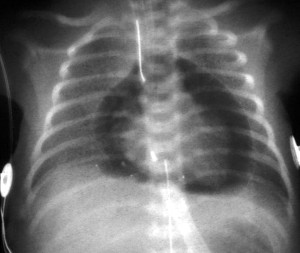So you should already know that potassium (K+) is VERY important in our bodies. From the action of K+ in the depolarization and repolarization which takes place in the heart, you can imagine that if there is too little, or too much potassium, then the effects will be present in the heart muscle.
HYPOkalemia
Hypo – meaning; less, not enough, below normal levels. Therefore, here we are talking about not enough potassium. Below is an EKG, and from my last posting where you became familiar with a normal EKG, you should be able to notice there are things about this EKG that are abnormal (If you noticed that, then well done!)

You can see that the U wave is really big, or in medical terms; prominent U waves are present. The T wave on the other hand is said to be “inverted” or the opposite direction that it should be, it can be flattened also. So just looking at this portion we can see that the REpolarization phase is definitely going to be affected by these changes.
I like to think of hypokalemia as making everything more depressed. A depressed person, moves slower, things take longer for them to do, they are disorganized and one thing runs into another.
Other things that can be seen in Hypokalemia in the EKG: the ST segment can be depressed (below the flat baseline), the PR interval can be prolonged (longer that should be) as well as the QT interval (due to the merging of T and U waves) and the P wave can get taller and longer.
Hypokalemia is serious because it can develop into life threatening arrhythmia such as Torsades de Pointe, Ventricular Tachycardia, Ventricular Fibrillation.
HYPERkalemia
This is the opposite, HYPER: too much, more than baseline, overload. Too much is just as dangerous and not enough, and as you can see from the strip below, the EKG will show you signs of high K+.

P waves here in this strip is missing; you might see small to no P waves, coupled with spiked T waves. Look at the T waves here, they are as tall as the QRS complex! In severe hyperkalemia, the QRS complex can widen also.
So as with hypokalemia, I like to think use little story concepts to remember the differences. So I like to think of hyperkalemia as an ADHD child: the T waves are hyper and the P waves are playing hide-&-go-seek. Repolarization period here is affected by surplus potassium by causing a faster repolarization period, and reducing the response of sodium channels in the myocardium; therefore slowing conduction around the heart and reducing the P wave in the strip.
So how can we tell when someone is hyperkalemic? Think: Blood test (straight forward, check K+ level), ABG (metabolic acidosis), hx renal disease (reduces elimination of K+), Addison’s disease, severe burns (mass K+ being released for cells/cell-lysis?), Digoxin toxicity.
What to know about potassium:
Potassium is mostly found inside the cells.
The normal range for potassium is 3.5-5.0 mEq/L








